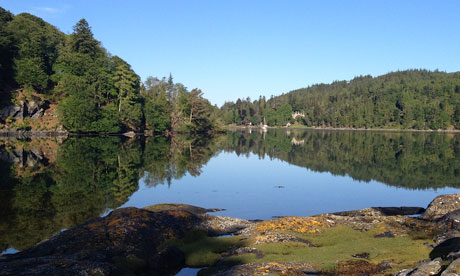
Three or four feet down and the sandy sea floor is thickly cast with razor clams and scallop shells. Towers of rainforest-green seaweed reach up towards the surface as we drift overhead in kayaks. And the sunlight, streaming down through the sparkling clear water, has turned the mother-of-pearl tones below into pure silver. It is quite extraordinary paddling through water so still and clear that the greens and yellows of the hills around are reflected in it. Like dipping into a liquid photograph.
Spotting baby seals on the rocks, we glide in close. But the adults are on to us. With soft "pops", seals are breaking the water all around the kayaks for a good old stare, like a gang of Labrador puppies. Gazing into their soft black eyes it's easy to see how legends of the Selkie – seals taking human form – were inspired.
We have been out for hours, exploring the sheltered bays and sandy islands of Loch nan Uamh, a sea loch close to Arisaig and some 35 miles out of Fort William. My children, 14 and 10 years old, are in their own kayaks, both beginners, but closely shadowed by our expert guide and canoeist Stuart Hood. No one is bored or tired, no one has capsized. No one wants to stop.
As a Scot, maybe I've a bias towards the wildness and the colours of this landscape, but the beauty of the timeless West Highland coast on such a sun-drenched day is unbeatable. And this is accessible wilderness. You no longer need to have a loyalty card with a mountaineering shop to qualify to be part of this remarkable, remote part of the British Isles.
Our family of four is spending a week exploring it by kayak and Canadian canoe, by train and by foot. Stuart, our guide from Wilderness Scotland, is easy-going and unassuming, and also a font of knowledge and a meticulous safety checker. He has kitted us out in our super-modern waterproof gear that makes us look like a family of Scandinavian traffic cops, but about which even the teenager doesn't complain. It's Stuart who finds us a silver-sanded island with a ruined castle to stop on for lunch and then makes tea and extravagant sandwiches while we explore it.
Most nights we sleep at the Glenuig Inn, an eco-hotel with a charming bar and locally sourced menu, on its own little bay where guests can simply haul up their sea-kayaks and stroll past the wandering sheep to the inn's 18th-century door. But we have opted for wild camping, too, and a night on an island is looming. The Glenuig staff make us home-smoked salmon breakfasts and wave us off with packed lunches. This time we take to Loch Moidart in sturdy Canadian canoes, two to a boat with room for tents and supplies, and Stuart's dog.
A little way up the loch lies our private island camp. As the canoes slide on to the beach, there's a great splash. A deer that had been enjoying some private grazing on the island takes to her heels and swims on for a less congested spot. Our tents up and mozzie nets down, the fire lit and hot pasta dinner cooking away, that clear-skied evening is already looking fairly beautiful when the Highlands throws in a late sunset to make a pointillist weep.
It dulls the pain of a visit from the midges. They arrive and stay for around an hour: we all whip on the very latest fine net hat invention and sit close to the fire until they clear off again as darkness falls. The other possible problem doesn't show at all. No rain. Which is a shame as a summer shower can really show the waterfalls and foamy hill streams at their atmospheric best.
It is incredible how much colour this scenery can contain. The long days here – Scotland has four hours more daylight than London during summer – are driest and sunniest in May and June, although July is the warmest and August is the time to catch the purple of the Highland heather. September and October are for the reds – the dramatic shows of the rowan and birch.
We spend another day on the water, this time on the MV Sheerwater, a ferry from Arisaig to the archipelago of Eigg, Rum, Canna and Muck. We opt for a few hours wandering around Eigg – 12 square miles of geographical wonders, "singing sands" (beaches of quartz that ring out when dry), puffins, eagles and caves, including the Massacre Cave – site of a 16th-century slaying of the island's 395 inhabitants. History echoes through this part of Scotland, where Bonnie Prince Charlie raised the Jacobite standard of rebellion, and many other battles and feuds have been fought since.
It's also a place to find traces of a more modern hero. The Jacobite Express used in the Harry Potter films chugs between Mallaig and Fort William twice a day, charging across the Glenfinnan Viaduct with its spectacular view down Loch Shiel. A little boy across from us did the whole journey plugged into a Harry Potter audio CD, his eyes shining like a Hogwarts' first year. I defy anyone not to be delighted by this beautiful steam train – or the genuine magic of the West Highlands.
Essentials
Tracy McVeigh's trip was provided by Wilderness Scotland which offers 4-7 day guided family holidays from £475 per adult and £365 per child (01479 420 020; wildernessscotland.com). B&B was provided by Old Lodge Library, Arisaig (oldlibrary.co.uk) which has doubles from £48, and Glenuig Inn, Glenuig (01687 470 219; glenuig.com) doubles from £100. Car hire was with Easy Drive car rental, Fort William. (01397 701 515; easydrivescotland.co.uk).Sheerwater Wildlife Cruises (arisaig.co.uk) has return fares from Arisaig to Eigg for £18. Caledonian sleeper trains travel from London Euston to Fort William (scotrail.co.uk)

